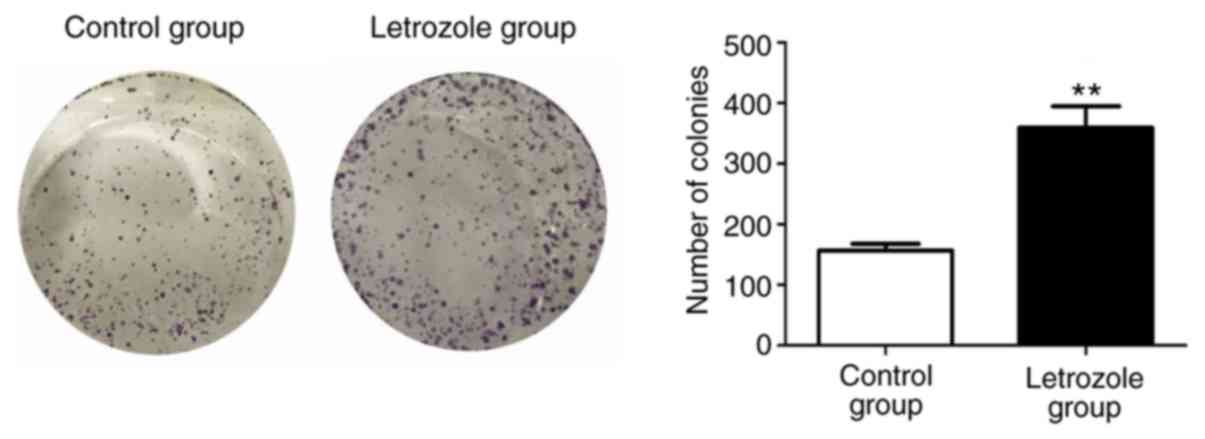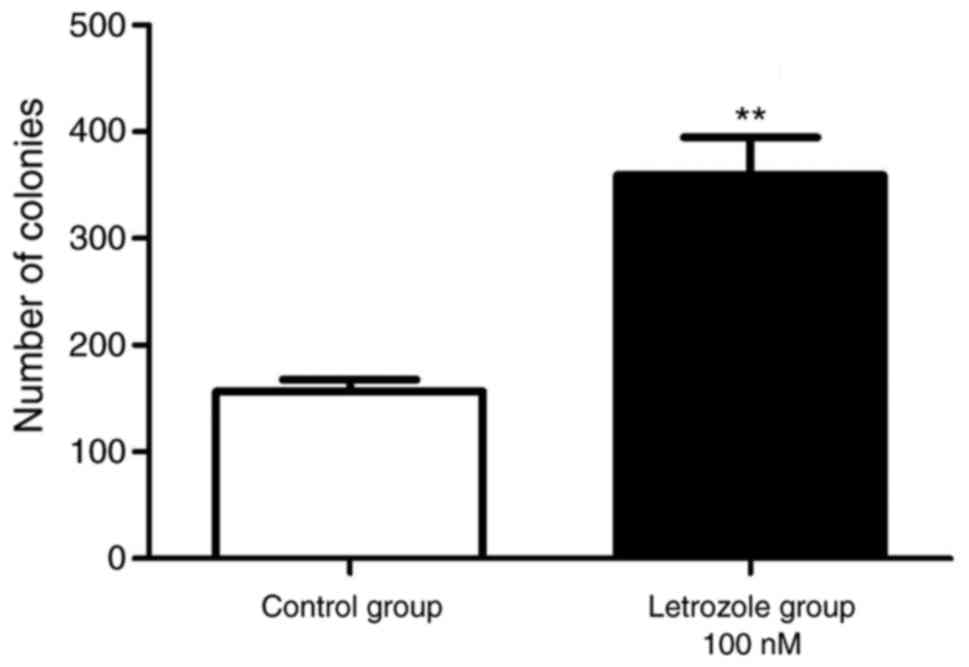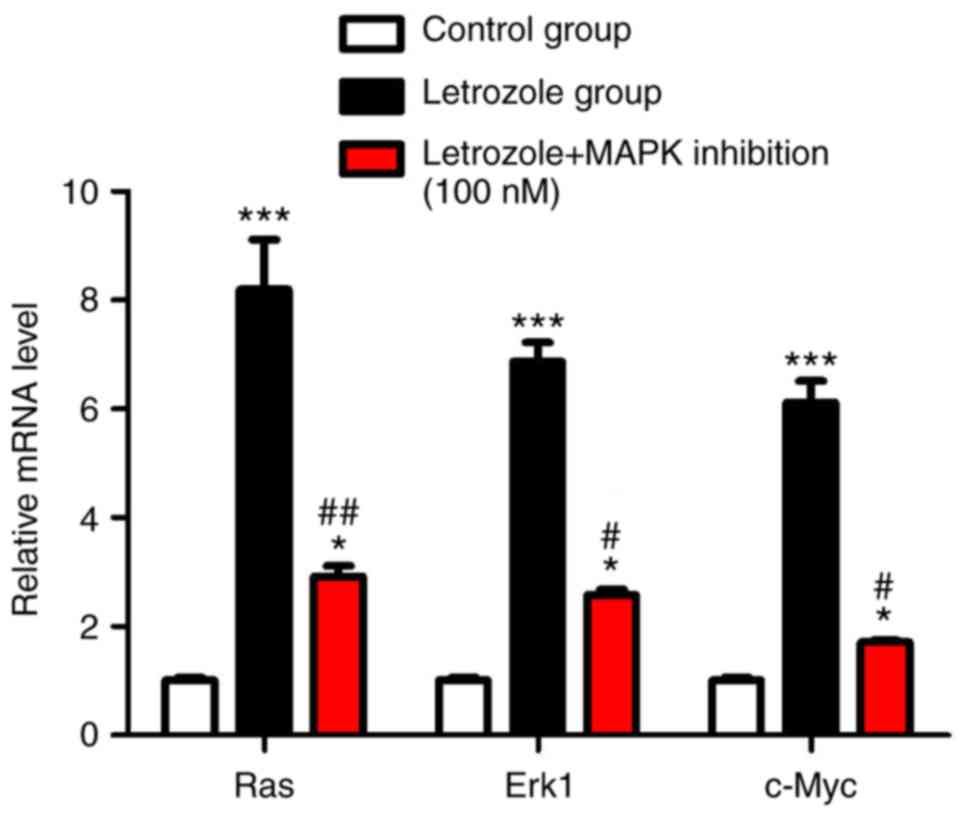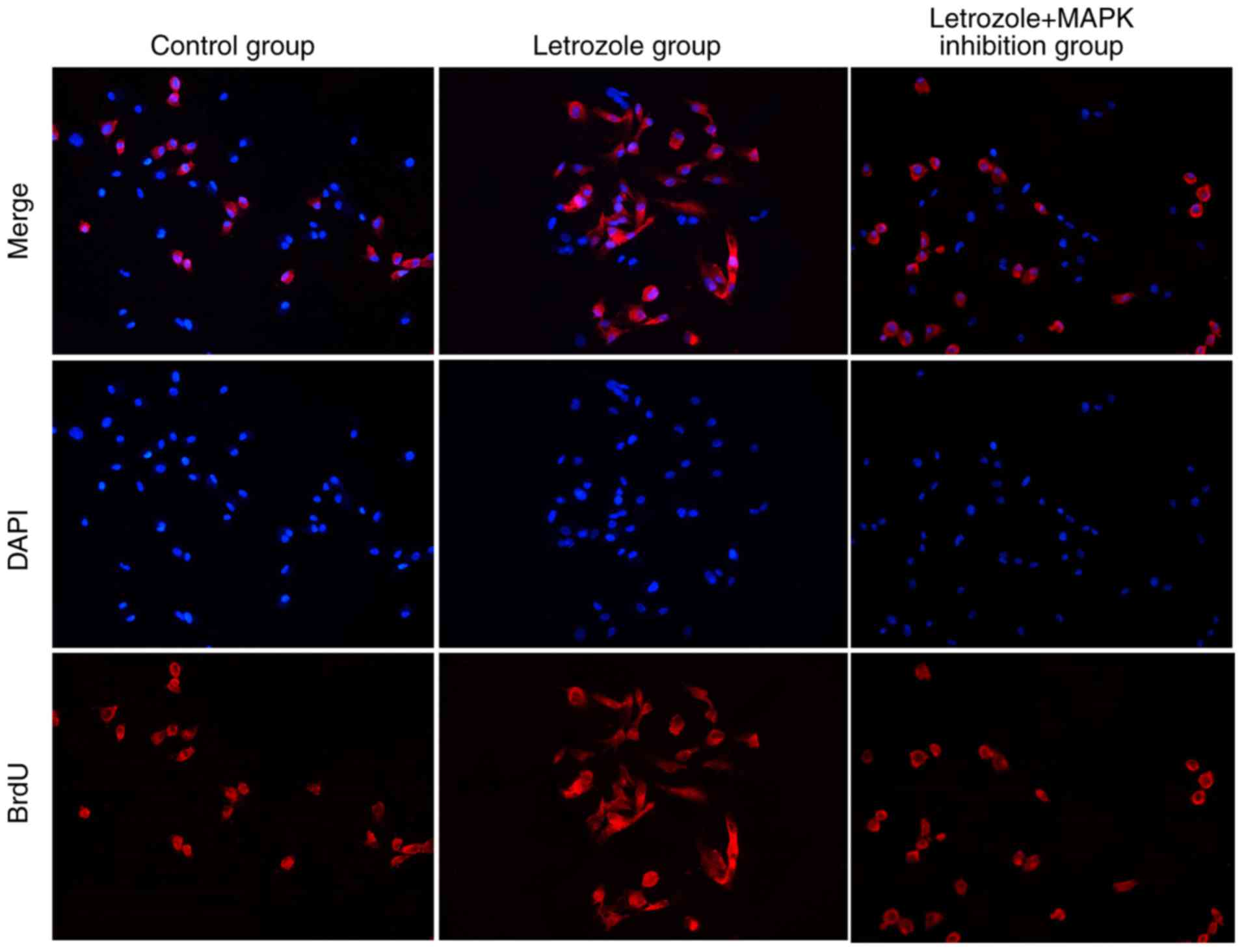Effect of aromatase inhibitor letrozole on the proliferation of spermatogonia by regulating the MAPK pathway
- Authors:
- Published online on: April 20, 2018 https://doi.org/10.3892/etm.2018.6081
- Pages: 5269-5274
Abstract
Introduction
Infertility is an important global health problem that causes great distress to 15% of couples (1). Findings have shown that 50–60% of the cases are due to male factors. Semen abnormalities including oligozoospermia and asthenozoospermia or azoospermia have been reported to be the main causes of infertility in men (2). Although the current test-tube baby technique solves the fertility problems of some patients, the technique has many shortcomings such as low success rate, high cost and the proneness of fetus to disease (3).
At present, the important treatment methods for oligozoospermia, asthenozoospermia and other symptoms caused by different pathological conditions in males include endocrine therapy, anti-inflammatory therapy, supplementation of trace elements and arginine (4,5). However, there is still a lack of clinically effective drug treatments for the above diseases. Letrozole is a new generation of highly selective aromatase inhibitor. It is a synthetic benzotriazole derivative that is used mainly in the radiotherapy and chemotherapy for breast cancer (6,7). A recent report also suggested the use of the aromatase inhibitor letrozole for the successful treatment of male infertility and human non-obstructive azoospermia (8). However, its molecular mechanism is not yet clear. Thus, the relationship between letrozole and mitogen-activated protein kinase (MAPK) signaling pathways and their respective effects on the proliferation of mouse spermatogonia were focus areas of the present study.
The primary aim of the present study was to explore mechanism of action of letrozole that has been shown to promote the MAPK pathway including RAS. APS-2-79 is an inhibitor, which was utilized in the present study to confirm the stimulatory actions of letrozole.
Materials and methods
Reagents
MAPK pathway inhibitor, APS-2-79, was procured from Selleck Chemicals (cat. no. S8355; Houston, TX, USA). Letrozole in the test was procured from MCE Corp. (cat. no. CGS-20267; Shanghai, China).
Cell culture
Spermatogonia of GC-1 spg mice were purchased from the Cell Bank, Shanghai Institutes for Biological Sciences, Chinese Academy of Sciences (Shanghai, China) and cultured in Roswell Park Memorial Institute (RPMI)-1640 medium containing 10% fetal bovine serum as well as 100 U/ml penicillin and streptomycin. Cells in the cell culture flask were incubated in the environment containing 5% CO2 at 37°C. The Ethics Committee of Chongqing Three Gorges Central Hospital approved the study.
Cell Counting Kit-8 (CCK-8) detection
GC-1 spg cells were inoculated in three 96-well plates at a density of 1×104/ml. The cells were completely adherent to the wall 24 h later. Letrozole (100 µl) at a final concentration of 0.1, 1, 10, 100, 1,000 nm was added and used for incubation for 24, 48 and 72 h, respectively. Then, 10 µl CCK-8 reagent (Biotool, Shanghai, China) was added to each well and incubated for 1 h in an incubator at 37°C. The optical density (OD) of each well was measured at the wavelength of 450 nm using a microplate reader (Bio-Rad, Hercules, CA, USA).
Cell plate clone
GC-1 spg cells in the logarithmic growth phase were selected, and digested with 0.25% trypsin into single cells. Cells were suspended in RPMI-1640 medium containing 10% fetal bovine serum, and the cell concentration was adjusted to 1×103/ml. Then, 1 ml cell suspension and 3 ml complete culture solution were placed in 6-well plates and gently rotated to disperse the cells evenly. The 6-well plates were incubated in a cell incubator with 5% CO2 at 37°C for 2–3 weeks. When a clone visible to the naked eye appeared in the 6-well plates, the culture was terminated. The supernatants were then discarded. This was followed by two washings with phosphate-buffered saline (PBS) 5 ml of 4% paraformaldehyde was utilized for fixing cells for 15 min. An appropriate amount of crystal violet staining solution was used for staining for 30 min, and then washed with double distilled water. Images were taken of the colonies with cell count more than 50.
Reverse transcription-polymerase chain reaction (RT-PCR)
The total ribonucleic acid (RNA) was extracted from GC-1 spg cells in each group using the PureLink® RNA Silica Column Extraction kit (Invitrogen; Thermo Fisher Scientific, Inc., Waltham, MA, USA) according to the manufacturer's instructions. Complementary deoxyribonucleic acid (cDNA) was synthesized with 1.0 µg total messenger RNA (mRNA) using a reverse transcription kit (SuperScript® VILO cDNA Synthesis kit and Master Mix; Invitrogen; Thermo Fisher Scientific, Inc.). The annealing was performed at 55°C while extension was completed at 72°C. The expression of each index was detected by the gene reactivation kit (Guangzhou, China) and quantitative PCR (Thermo Fisher Scientific, Inc.). The calculation formula of the expression level of mRNA as per kit: 2−ΔCq [ΔCq = Cq (target gene) - Cq (glyceraldehyde 3-phosphate dehydrogenase)]. The corresponding primer sequences are shown in Table I.
Western blot analysis
Cells in each treatment group were inoculated in 6-well plates, and an appropriate amount of protease inhibitor and protein lysate were added. The cell lysate was aspirated and centrifuged at 12,000 × g at 4°C for 30 min. Total protein (40 µg) was electrophoresed in sodium dodecyl sulfate (SDS)-polyacrylamide gel, followed by transfer to the polyvinylidene difluoride (PVDF) membrane. According to the instructions of the marker, the bands containing the target proteins were cut and incubated overnight with Ras (cat. no. ab52939), ERK1 (cat. no. ab17942), c-Myc (cat. no. ab32072), Ki-67 (cat. no. ab156956), proliferating cell nuclear antigen (PCNA) (cat. no. ab29) and GAPDH (cat. no. ab8245) antibodies. All the antibodies were procured from Abcam (Cambridge, UK). Dilutions were made with the blocking buffer (1:500 for all antibodies) and the incubation time was 12 h at 4°C. The membranes were visualized with an enhanced chemiluminescence (ECL) detection system (Bio-Rad Laboratories, Inc., Hercules, CA, USA), and gray scale analysis was performed using a gel analyzer. The bands were quantified by using ImageJ software.
Detection of cell proliferation by bromodeoxyuridine (BrdU) staining
Cells were inoculated on a chamber slide (NEST Science Co. Ltd., Shanghai, China) at a density of 10–20%. The cells were incubated for 48 h according to the test requirements by addition of letrozole and MAPK inhibitors. Before the termination of cell culture, BrdU (final concentration: 30 µg/l; MCE Corp.) was added, and the cells were further incubated at 37°C for 40 min. The culture medium was then discarded, and the slide was washed 3 times with PBS. Methanol was used for fixation for 10 min, after which the slide was dried with air. Subsequently, 0.3% H2O2-methanol was used for inactivating endogenous oxidases for 30 min. Bovine serum albumin (BSA) (5%) was used for sealing cells at room temperature for 1 h. Formamide was used for denaturation of nucleic acid at 100°C for 5 min. After cooling in the ice bath, PBS washing was performed, and the anti-mouse BrdU monoclonal antibody (working concentration = 1:50) was added. 4′,6-Diamidino-2-phenylindole (DAPI) was used for staining nuclei for 2 min. Ten high-power fields were randomly chosen to calculate the total number of cells in each field of vision and the number of BrdU-positive cells.
Statistical analysis
The results were analyzed using GraphPad Prism software (version 5.01; GraphPad Software, Inc., La Jolla, CA, USA). The t-test was used to compare the differences in samples between the two groups. One-way analysis of variance (ANOVA) was used to compare the differences in the mean among multiple groups and Tukey test was used as post hoc test. P<0.05 was considered to indicate a statistically significant difference. The LSD post hoc test was also performed for comparisons among groups.
Results
Detection of the effect of letrozole on the proliferation of spermatogonia by CCK-8
Six gradient concentrations were set for letrozole to treat mouse spermatogonia (GC-1 spg) for 24, 48 and 72 h, respectively. CCK-8 assay showed that letrozole could promote the proliferation of GC-1 spg cells and exhibited time and dose effects (Fig. 1). In the follow-up experiment, 100 nm letrozole was selected to treat cells for 72 h, and then the detection was performed.
Detection of the effect of letrozole on the proliferation of spermatogonia by the plate clone formation assay
The plate clone formation assay was used to further verify the effect of letrozole on the proliferation of GC-1 spg cells. As shown in Fig. 2, the number of cell colonies in the letrozole treatment was significantly higher than the control group (p<0.05).
Detection of the effects of letrozole on the MAPK pathway by RT-PCR
As MAPK is an important signaling pathway for cell proliferation, letrozole and letrozole + MAPK inhibitors were set to explore the relationship between letrozole and MAPK pathways. RT-PCR results showed that, letrozole significantly increased the mRNA levels of Ras/ERK1/c-Myc in the classical MAPK pathway (p<0.05) as compared to those of control group. Further, letrozole + MAPK inhibition significantly decreased the mRNA levels of Ras/ERK/c-Myc (p<0.05) (Fig. 3).
Detection of effects of letrozole on the MAPK pathway by western blot analysis
The results of western blot analysis were consistent with those of RT-PCR, which further verified that compared with those in the control group, letrozole significantly increased the protein levels of Ras/ERK1/c-Myc in the classical MAPK pathway (p<0.05). On the other hand, letrozole + MAPK inhibition significantly decreased the protein levels of Ras/ERK/c-Myc (p<0.05) (Fig. 4).
Detection of the expression of proliferation indexes
The protein expression levels of Ki-67 and PCNA (two classical proliferation indexes), were examined to further investigate the effects of letrozole on the proliferation of GC-1 spg cells. Letrozole significantly increased the protein levels of Ki-67 and PCNA (p<0.05) (Fig. 5), in comparison to the control group. The protein levels of Ki-67 and PCNA in the letrozole + MAPK inhibition group showed a significant declining trend as compared to the letrozole group (p<0.05).
Detection of effects of letrozole on cell proliferation by BrdU
The BrdU assay was used to detect the effects of letrozole and the MAPK pathway on the proliferation of GC-1 spg cells. The results (Fig. 6) indicated that the number of BrdU-stained cells in the letrozole group was higher than that in the control group, while that in the letrozole + MAPK inhibition group was significantly less in comparison to letrozole group.
Discussion
Oligozoospermia is a complex disease, which is caused by the combination of genetic factors and acquired conditions (9). The occurrence of spermatozoa is also a complex cell process, which is divided into the division stage (proliferation and differentiation of spermatogonia), the meiosis stage (meiosis of spermatogonia) and the haploid stage (from sperm cells to sperm differentiation) (10). In this process, the number of spermatogonia directly affects the production of sperm. Abnormalities in spermatogonia often lead to oligozoospermia, asthenozoospermia and sperm abnormalities (11). Therefore, improvement in the number of spermatogonia is crucial during male oligozoospermia.
Letrozole is considered as a safe as well as an effective aromatase inhibitor that could be orally taken. It has the ability to act as an aromatase inhibitor to decrease the estrogen level. In this way, it eliminates the stimulation of estrogen on tumor growth. Besides, no potential toxicity to the normal systemic system has been reported. Moreover, target organs showed good tolerance and strong pharmacological effects (12,13). The recent 3-phase clinical trials utilized letrozole as a chemotherapy drug for postmenopausal metastatic breast cancer (14). In addition, the literature also suggested that the main source of estrogen in men is the process that showed aromatase-catalyzed testosterone into estradiol. So, it has a strong negative feedback on the hypothalamic-pituitary axis so as to reduce the production and the release of follicle stimulating hormone (FSH). Aromatase inhibitors could inhibit the conversion of testosterone into estradiol; thereby reduced the concentration of serum estradiol. Thus, the negative feedback on the hypothalamic-pituitary axis increased the levels of serum FSH (15). FSH regulates the development, growth, adolescent sexual maturity and a series of physiological processes related to reproduction, which acts on seminiferous tubules of the testis and promotes sperm formation. This, in turn, might exert positive effects on sperms (16). However, concerning the molecular mechanism, the main role of letrozolein in the signaling pathway has not yet been reported.
MAPK pathway plays important roles in the differentiation, proliferation, survival and migration of mammalian cells (17). The four major MAPK cascade reactions [ERK1/2, c-Jun N-terminal kinase 1/3 (JNK1/3), p38 and ERK5] in mammalian cells have been well studied. The action mechanism of cascade reactions includes activation of the Ras protein-coupled receptor of the Ras family [such as Ras, cell division control protein 42 homolog (Cdc42) and Rac], followed by the activation of mitogen activated protein kinase kinases (MAPKKs) and MAPKs (18). A study of Jaldety and Breitbart showed that ERK1 and 2 were expressed at all stages of mouse germ cells, but the activation of ERK1/2 peaks in mouse spermatogonia (19). In addition, ERK1/2 actively participates in the process of mouse spermatogonial stem cell factor (SCF) accelerating the cell cycle progression by inducing the transient activation of MAPK cascades (20). Besides, c-Myc (as the target gene of the MAPK pathway), is involved in the process of cells from G0 to S phases, and its increased expression positively regulates cell proliferation (21).
In the present study, in vitro cell experiments showed that letrozole significantly increased the proliferation of mouse GC-1 spg cells accompanied by the activation of the MAPK signaling pathway. However, the exploration of RAF is also crucial for concrete conclusion. So, it could be one of the prime limitations of the study but we will include this in our future studies. We did not include APS-2-79 group in the present study, which is the second limitation of the study. Experiments using MAPK inhibitors found that MAPK signaling pathway played an important role in promoting the proliferation ability of spermatogonia. Based on the above experimental results, we speculated that letrozole might have a good clinical effects on infertility caused by male oligozoospermia and asthenozoospermia. Thus, letrozole has strong potential for its clinical application against oligozoospermia. However, further studies are essential for concrete conclusions.
Acknowledgements
Not applicable.
Funding
This study was funded by the Medical Research Project of Chongqing Health and Family Planning Commission (2016MSXM114).
Availability of data and materials
The datasets used and/or analyzed during the current study are available from the corresponding author on reasonable request.
Authors' contributions
ShundeW wrote the manuscript and was responsible for cell culture. ShuhongW and HL performed CCK-8 assay, XL was devoted to PCR. MX and JW helped with western blot analysis, ML and TL contributed to BrdU staining. All authors read and approved the final version of the manuscript.
Ethics approval and consent to participate
The Ethics Committee of Chongqing Three Gorges Central Hospital (Chongqing, China) approved the study.
Consent for publication
Not applicable.
Competing interests
The authors declare that they have no competing interests.
References
|
Glazer CH, Bonde JP, Eisenberg ML, Giwercman A, Hærvig KK, Rimborg S, Vassard D, Pinborg A, Schmidt L and Bräuner EV: Male infertility and risk of nonmalignant chronic diseases: A systematic review of the epidemiological evidence. Semin Reprod Med. 35:282–290. 2017. View Article : Google Scholar : PubMed/NCBI | |
|
Bridges N, Trofimenko V, Fields S, Carrell D, Aston K and Hotaling J: Male factor infertility and clomiphene citrate: A meta-analysis - the effect of clomiphene citrate on oligospermia. Urol Pract. 2:199–205. 2015. View Article : Google Scholar : PubMed/NCBI | |
|
Chirputkar R and Vaidya A: Understanding infertility and the potential role of stem cells in infertility treatment: A short communication. Int J Reprod Fertil Sex Health. 1:37–40. 2015. | |
|
Sami MA, Nazar H and Usmanghani K: Idiopathic oligospermia treatment: An alternate approach. Int J Med Med Sci. 7:74–79. 2015. View Article : Google Scholar | |
|
Hezelgrave N, Abbott D and Shennan AH: Pre-implantation genetic diagnosis in oligozoospermiaChallenging Concepts Obstet Gynaecol. Oxford University Press; Oxford: pp. 49–59. 2014 | |
|
Legro RS, Brzyski RG, Diamond MP, Coutifaris C, Schlaff WD, Casson P, Christman GM, Huang H, Yan Q, Alvero R, et al: NICHD reproductive medicine network: Letrozole versus clomiphene for infertility in the polycystic ovary syndrome. N Engl J Med. 371:119–129. 2014. View Article : Google Scholar : PubMed/NCBI | |
|
André F, Stemmer SM, Hortobagyi GN, Burris HA, Paluch-Shimon S, Campone M, Villanueva C, Chan A, Wist E, Marschner N, et al: Ribociclib + letrozole for first-line treatment of HR+, HER2− ABC: Efficacy, safety, and pharmacokinetics. Eur J Cancer. 69:S72016. View Article : Google Scholar | |
|
Diamond MP, Legro RS, Coutifaris C, Alvero R, Robinson RD, Casson P, Christman GM, Ager J, Huang H, Hansen KR, et al: NICHD Reproductive Medicine Network: Coutifaris. Letrozole, gonadotropin, or clomiphene for unexplained infertility. N Engl J Med. 373:1230–1240. 2015. View Article : Google Scholar : PubMed/NCBI | |
|
Milardi D, Luca G, Grande G, Ghezzi M, Caretta N, Brusco G, De Filpo G, Marana R, Pontecorvi A, Calafiore R, et al: Prednisone treatment in infertile patients with oligozoospermia and accessory gland inflammatory alterations. Andrology. 5:268–273. 2017. View Article : Google Scholar : PubMed/NCBI | |
|
Nozawa YI, Yao E, Gacayan R, Xu SM and Chuang PT: Mammalian Fused is essential for sperm head shaping and periaxonemal structure formation during spermatogenesis. Dev Biol. 388:170–180. 2014. View Article : Google Scholar : PubMed/NCBI | |
|
Xu Y, Wang N, Yu Y, Li Y, Li YB, Yu YB, Zhou XQ and Sun ZW: Exposure to silica nanoparticles causes reversible damage of the spermatogenic process in mice. PLoS One. 9:e1015722014. View Article : Google Scholar : PubMed/NCBI | |
|
Finn RS, Crown JP, Lang I, Boer K, Bondarenko IM, Kulyk SO, Ettl J, Patel R, Pinter T, Schmidt M, et al: The cyclin-dependent kinase 4/6 inhibitor palbociclib in combination with letrozole versus letrozole alone as first-line treatment of oestrogen receptor-positive, HER2-negative, advanced breast cancer (PALOMA-1/TRIO-18): A randomised phase 2 study. Lancet Oncol. 16:25–35. 2015. View Article : Google Scholar : PubMed/NCBI | |
|
Finn RS, Martin M, Rugo HS, Jones S, Im SA, Gelmon K, Harbeck N, Lipatov ON, Walshe JM, Moulder S, et al: Palbociclib and letrozole in advanced breast cancer. N Engl J Med. 375:1925–1936. 2016. View Article : Google Scholar : PubMed/NCBI | |
|
Dickler MN, Barry WT, Cirrincione CT, Ellis MJ, Moynahan ME, Innocenti F, Hurria A, Rugo HS, Lake DE, Hahn O, et al: Phase III trial evaluating letrozole as first-line endocrine therapy with or without bevacizumab for the treatment of postmenopausal women with hormone receptor-positive advanced-stage breast cancer: CALGB 40503 (Alliance). J Clin Oncol. 34:2602–2609. 2016. View Article : Google Scholar : PubMed/NCBI | |
|
Noorafshan A, Ahmadi M, Mesbah SF and Karbalay-Doust S: Stereological study of the effects of letrozole and estradiol valerate treatment on the ovary of rats. Clin Exp Reprod Med. 40:115–121. 2013. View Article : Google Scholar : PubMed/NCBI | |
|
Simoni M, Santi D, Negri L, Hoffmann I, Muratori M, Baldi E, Cambi M, Marcou M, Greither T, Baraldi E, et al: Treatment with human, recombinant FSH improves sperm DNA fragmentation in idiopathic infertile men depending on the FSH receptor polymorphism p.N680S: A pharmacogenetic study. Hum Reprod. 31:1960–1969. 2016. View Article : Google Scholar : PubMed/NCBI | |
|
Bernet JD, Doles JD, Hall JK, Tanaka Kelly K, Carter TA and Olwin BB: p38 MAPK signaling underlies a cell-autonomous loss of stem cell self-renewal in skeletal muscle of aged mice. Nat Med. 20:265–271. 2014. View Article : Google Scholar : PubMed/NCBI | |
|
Loi S, Dushyanthen S, Beavis PA, Salgado R, Denkert C, Savas P, Combs S, Rimm DL, Giltnane JM, Estrada MV, et al: RAS/MAPK activation is associated with reduced tumor-infiltrating lymphocytes in triple-negative breast cancer: Therapeutic cooperation between MEK and PD-1/PD-L1 immune checkpoint inhibitors. Clin Cancer Res. 22:1499–1509. 2016. View Article : Google Scholar : PubMed/NCBI | |
|
Jaldety Y and Breitbart H: ERK1/2 mediates sperm acrosome reaction through elevation of intracellular calcium concentration. Zygote. 23:652–661. 2015. View Article : Google Scholar : PubMed/NCBI | |
|
Hu X, Tang Z, Li Y, Liu W, Zhang S, Wang B, Tian Y, Zhao Y, Ran H, Liu W, et al: Deletion of the tyrosine phosphatase Shp2 in Sertoli cells causes infertility in mice. Sci Rep. 5:129822015. View Article : Google Scholar : PubMed/NCBI | |
|
Tögel L, Nightingale R, Chueh AC, Jayachandran A, Tran H, Phesse T, Wu R, Sieber OM, Arango D, Dhillon AS, et al: Dual targeting of bromodomain and extraterminal domain proteins, and WNT or MAPK signaling, inhibits c-MYC expression and proliferation of colorectal cancer cells. Mol Cancer Ther. 15:1217–1226. 2016. View Article : Google Scholar : PubMed/NCBI |















